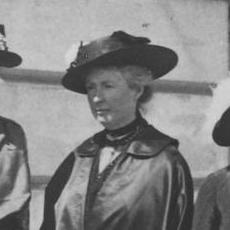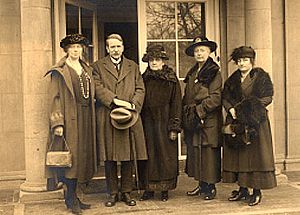Cornelia Ramondt-Hirschmann facts for kids
Quick facts for kids
Cornelia Ramondt-Hirschmann
|
|
|---|---|

in 1915
|
|
| Born |
Susanna Theodora Cornelia Hirschmann
29 July 1871 The Hague, the Netherlands
|
| Died | 29 July 1957 (aged 86) Hilversum, the Netherlands
|
| Nationality | Dutch |
| Other names | Cor Ramondt-Hirschmann |
| Occupation | teacher, feminist, pacifist |
| Years active | 1890–1940 |
| Known for | peace activism |
Cornelia Ramondt-Hirschmann (born July 29, 1871 – died November 20, 1957) was a Dutch teacher and activist. She was a feminist, meaning she believed in equal rights for women. She was also a pacifist, which means she worked for peace and against war.
Cornelia was very active in the early 1900s. During World War I, she joined other women who wanted world leaders to create a group to help solve problems peacefully. Their hard work helped lead to the creation of the League of Nations after the war. From 1935 to 1937, she was one of the main leaders of the Women's International League for Peace and Freedom (WILPF).
Contents
Early Life and Education
Susanna Theodora Cornelia Hirschmann was born on July 29, 1871, in The Hague, Netherlands. Everyone called her "Cor." Her father, Frederik Hirschmann, worked for the Royal Netherlands Navy. He passed away when Cor was nine years old.
Cor was raised by her mother in The Hague. She went to the Christian Educational Academy. In 1889, she earned her teaching certificate for primary school. The next year, she also got a certificate to teach French.
Starting Her Career
After finishing school, Cor and her mother moved to Nijmegen. Cor started teaching to help support them. In 1893, she earned another certificate for physical education.
While in Nijmegen, she likely met Dirk Ramondt, who worked for the postal service. Soon after, she and her mother moved to Utrecht. Cor married Dirk Ramondt there on June 15, 1899. The young couple then moved to Breda, where their daughter, Sophie, was born.
Working for Women's Rights and Peace
Cornelia Ramondt-Hirschmann soon became involved in the women's rights movement in the Netherlands. She supported groups like the Vereeniging voor Vrouwenkiesrecht (VVK), which worked for women's right to vote. She also supported the International Alliance of Women (IWSA).
In 1903, her family moved back to The Hague. Cornelia became a secretary for the Dutch Women's Council (Dutch: Nederlandse Vrouwen Raad (NVR)). She worked with other important feminists like Johanna Naber. Around this time, she also became interested in theosophy, a type of spiritual philosophy. She often gave talks about it.
In 1912, the family moved to Amsterdam. Cornelia then became very active in the pacifist movement, which worked for peace.
The 1915 Women's Peace Congress
Cornelia helped organize the International Congress of Women in 1915. This big meeting was held in The Hague. At the conference, Cornelia was chosen to lead the Dutch branch of a new group called the International Committee of Women for Permanent Peace (ICWPP).
After the Congress, two groups of women were formed. Their job was to share the ideas from the meeting with leaders of different countries. Cornelia was part of the group that visited countries in Scandinavia (like Denmark and Norway) and Russia. Other members included Emily Greene Balch and Chrystal Macmillan. The other group, led by Jane Addams, spoke with leaders of countries that were at war.
Meeting with Leaders
Cornelia's group visited Denmark and Norway. In Sweden, they spoke with the Foreign Minister, Knut Wallenberg. He said Sweden would be willing to host a peace meeting if two warring countries agreed to join. This was a big step!
Next, the group went to Russia. They met with the Foreign Minister, Sergei Sazonov. He agreed that Russia would not be against a neutral country hosting a peace meeting.
When Cornelia's group returned to The Hague, they learned that Jane Addams's group had gotten a similar agreement from the Prime Minister of France. Cornelia and her fellow activists, including Aletta Jacobs, continued their efforts. They spoke with German and British officials. While these officials didn't fully commit, they also didn't say no to the idea of a neutral peace meeting.
With these statements, the Swedish Foreign Minister, Wallenberg, agreed to present the peace plan to the Swedish government. Meanwhile, Aletta Jacobs tried to convince the Prime Minister of the Netherlands, Pieter Cort van der Linden, to host the conference. However, they couldn't convince President Woodrow Wilson of the United States to act. The official conference for the League of Nations only happened after the war ended.

Continuing Peace Work
In 1919, Cornelia traveled to a meeting in Zürich. There, the ICWPP changed its name to the Women's International League for Peace and Freedom (WILPF). Cornelia became an international secretary for WILPF in 1921 and served in that role until 1936.
She divorced her husband in 1923 and gained custody of her daughter. From 1924 to 1926, Cornelia traveled across the United States. She gave speeches about peace while her daughter studied at Bryn Mawr College.
From 1927 to 1930, she was the General Secretary of the Dutch Theosophical Society. In 1934, Cornelia and her daughter moved to Hilversum. That same year, Cornelia organized a quiet protest for peace called the Women's Peace Walk. Women marched through The Hague every year on May 18 until 1940.
In 1935, Cornelia protested against the arrests of people who spoke out against the Nazis. From 1935 to 1937, she was one of the three main international leaders of the WILPF. She also helped raise money for people affected by the Spanish Civil War. In 1938, she returned to The Hague. When Germany invaded the Netherlands, she moved back to Hilversum to live with her daughter and stopped her peace work.
Death and Legacy
Cornelia Ramondt-Hirschmann passed away on November 20, 1957, at her daughter's home in Hilversum. She was a very important woman in the peace and women's rights movements of her time. She believed that when women took part in international politics, it would bring more kindness and understanding to how countries were governed. She felt their involvement was very important for a more peaceful world.
See also
 In Spanish: Cornelia Ramondt-Hirschmann para niños
In Spanish: Cornelia Ramondt-Hirschmann para niños

